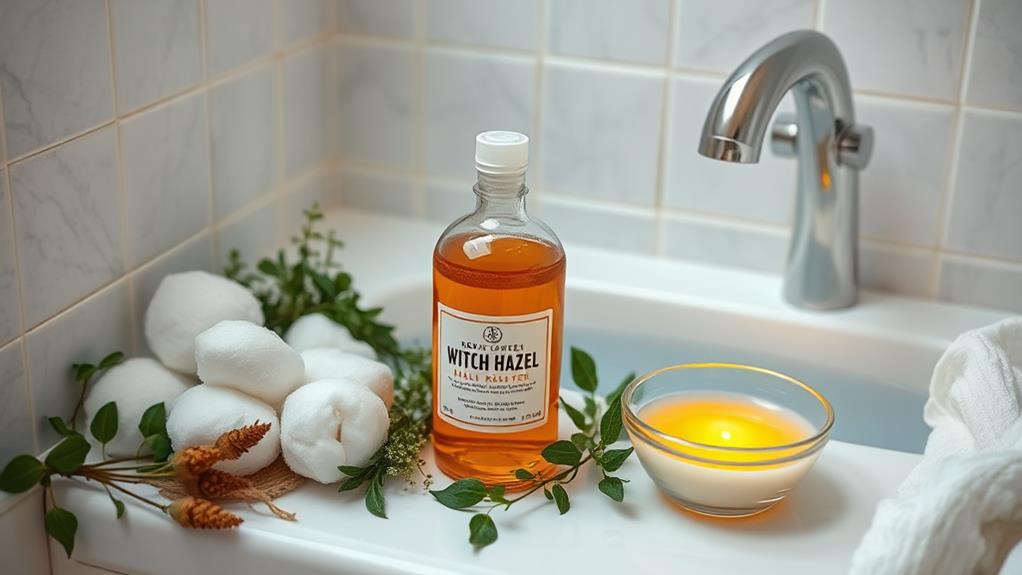Witch hazel might just be one of nature's most underrated remedies. You might know it for its soothing properties, but its benefits extend far beyond a simple skin treatment. From reducing inflammation to promoting wound healing, it's become a staple in many skincare routines. However, there are aspects of witch hazel that you may not be aware of, including its historical significance and potential side effects. Understanding these elements could change how you approach this versatile extract. What else could witch hazel offer you?
Overview of Witch Hazel

Witch hazel is a natural extract from the Hamamelis virginiana plant, known for its powerful anti-inflammatory and astringent properties. This remarkable plant has been used for centuries, particularly by Native Americans, who recognized its potential for treating skin irritations, inflammation, and minor wounds. You might find witch hazel in various forms like liquid, ointments, and creams, making it a versatile option for your skincare routine.
When you apply witch hazel topically, it can help tighten skin, reduce pore size, and even alleviate acne-related issues. That's why it's commonly included in over-the-counter products. Its astringent properties work by removing excess oil and impurities, which can be a game changer for those struggling with oily skin.
The extract's anti-inflammatory benefits can also soothe redness and swelling, making it a go-to remedy for irritated skin.
One of the best parts about witch hazel is its well-established safety profile. Most people can use it without any major concerns. However, if you're new to it, patch testing is a smart idea. Just apply a small amount to a discreet area of your skin and wait to see if any irritation occurs. This simple step helps guarantee you get the benefits of witch hazel while avoiding any unwanted reactions.
Key Benefits for Skin
For anyone looking to enhance their skincare routine, witch hazel offers a plethora of benefits that can transform your skin. This natural astringent tightens pores and reduces excess oil, making it a fantastic option for treating acne and preventing breakouts. If you struggle with oily skin, incorporating witch hazel can help keep those pesky blemishes at bay.
Another significant advantage of witch hazel is its anti-inflammatory properties. It can effectively decrease redness and swelling associated with skin irritations. Whether you're dealing with eczema, sunburn, or general irritation, witch hazel provides soothing relief.
Studies have even shown that it can suppress erythema, or skin redness, by up to 27%, enhancing its ability to calm inflamed skin.
Witch hazel isn't just about soothing; it also protects your skin from environmental damage and pollution. By maintaining your skin's barrier integrity, it helps keep harmful elements at bay.
Plus, the presence of tannins in witch hazel contributes to its antioxidant benefits, supporting overall skin health. These tannins can also aid in wound healing, making witch hazel a versatile tool for anyone's skincare arsenal.
Applications and Usage

Witch hazel isn't just great for your skin; it has a variety of uses that can really come in handy.
You can easily apply it to soothe minor irritations or even use it for oral care by gargling with it to ease a sore throat.
Whether you're targeting pesky bug bites or looking for relief from scalp issues, witch hazel proves to be a versatile natural remedy.
Topical Applications
When it comes to soothing skin issues, witch hazel shines as a versatile natural remedy. You can use it for various topical applications that provide soothing relief for minor skin irritations.
If you're dealing with bug bites, sunburn, or poison ivy, witch hazel works wonders by reducing redness and inflammation. Its natural astringent properties help tighten pores and reduce excess oil, making it an excellent choice for acne treatment as well.
Witch hazel isn't just for your face; it's also effective for hemorrhoid relief. Applying the extract can alleviate symptoms like itching and discomfort, providing you with much-needed comfort.
Available in different forms like wipes, sprays, and creams, it allows for flexible application on both your face and body.
Studies show that topical application of witch hazel can suppress erythema—skin redness—by up to 27%. This highlights its effectiveness in calming irritated skin and restoring balance.
Oral Uses
While witch hazel is primarily known for its topical benefits, it has a history of oral use for various ailments. Traditionally, people have used witch hazel to treat diarrhea, tuberculosis, and even respiratory conditions.
However, it's crucial to recognize that these claims lack robust clinical evidence. If you're considering oral uses, small doses (about 3-4 teaspoons) are generally deemed safe, but caution is key. Higher amounts can lead to gastrointestinal issues and possible liver damage.
Because of safety concerns, the FDA labels witch hazel with a "For external use only" warning, stressing that you shouldn't consume it without medical supervision. Historical applications include using witch hazel for colds and fevers, but modern research hasn't confirmed these benefits for oral use.
If you're pregnant or nursing, extra caution is necessary since reliable safety data is lacking for these groups. Always consult with a healthcare provider before trying witch hazel orally, especially if you have any underlying health conditions.
Potential Side Effects
When using witch hazel, it's important to be aware of potential side effects, especially if you have sensitive skin.
You might experience minor irritation or dryness, so a patch test is a smart idea before applying it widely.
Additionally, if you're considering oral use, remember that while small doses are generally safe, larger amounts can lead to uncomfortable gastrointestinal issues.
Skin Irritation Risks
Witch hazel can offer numerous benefits for the skin, but it also poses several skin irritation risks, especially for those with sensitive skin. Its astringent properties, while effective for tightening skin and reducing oil, can lead to dryness and irritation. If you have sensitive skin, you might experience redness, burning sensations, or peeling after use. These reactions are more likely if you apply witch hazel to broken or oozing areas.
It's essential to perform patch testing before using witch hazel more broadly. This simple step can help you avoid potential allergic reactions or further skin irritation. If you do experience irritation, you should stop using it immediately.
Additionally, be careful to avoid eye contact, as this can cause inflammation; rinse your eyes thoroughly with water if contact occurs.
While witch hazel is generally safe for topical use, keep in mind that it contains tannins, which can sometimes contribute to adverse reactions in sensitive individuals.
Always listen to your skin and consult a doctor if you're unsure about using witch hazel. Your skin deserves the best care, so stay informed and cautious!
Oral Use Caution
Oral use of witch hazel requires caution due to potential side effects that can arise from improper dosing. While many people find witch hazel beneficial for skin issues, ingesting it can lead to gastrointestinal issues, especially when taken in large amounts.
Its high tannin content can irritate your stomach and, in extreme cases, even cause liver damage. So, it's crucial to stick to recommended dosages, typically around 3-4 teaspoons, to stay safe.
You should also be aware that the FDA has labeled many witch hazel products with a "For external use only" warning, which highlights the risks of oral consumption. If you're pregnant or nursing, it's particularly important to exercise caution.
Reliable safety data on witch hazel for oral use is lacking, so consulting your healthcare provider is a smart move.
If you do decide to try witch hazel orally, keep an eye out for any signs of stomach upset. By being mindful of these potential side effects and heeding oral use caution, you can enjoy the benefits of witch hazel safely.
Scientific Research Findings

Recent scientific research highlights the numerous benefits of witch hazel, particularly in dermatological applications.
You'll be fascinated to learn that studies have shown witch hazel can considerably reduce acne lesions and skin redness, proving its effectiveness in treating inflammatory skin conditions like eczema. This is backed by clinical trials that demonstrate how a 10% hamamelis distillate effectively reduces UV-induced erythema, suggesting it's a great option for sunburn relief too.
In pediatric dermatology, an observational study reported positive outcomes for children suffering from various skin disorders, indicating that witch hazel is both safe and effective for young patients. This is reassuring for parents looking for gentle skin care solutions.
Witch hazel also contains tannins, which research confirms have antiviral properties. Laboratory studies have shown that these tannins exhibit activity against influenza A and human papillomavirus, making witch hazel not just a skincare hero but a potential defender against viruses as well.
Moreover, its anti-inflammatory effects have been validated in clinical studies, supporting its traditional use in managing conditions such as eczema and minor skin irritations.
So, whether you're dealing with acne, seeking relief from sunburn, or looking for a safe option for your child's skin, witch hazel might just be the answer you've been searching for.
With all this scientific backing, it's clear that witch hazel is more than just an old remedy; it's a powerful tool for skin health.
Historical Significance and Uses
The historical significance of witch hazel is deeply rooted in its use by Native Americans, who recognized its medicinal properties long before it became popular in modern herbal medicine. Derived from the Hamamelis virginiana plant, witch hazel has been a trusted natural remedy for centuries. Native Americans used it primarily to treat skin irritations and inflammation, applying the extract directly to the affected areas for relief.
In the early 20th century, witch hazel gained popularity as an over-the-counter skincare product. People turned to it for various ailments, including hemorrhoids, varicose veins, and minor skin irritations. Its historical uses highlight its effectiveness in soothing discomfort.
You might be surprised to learn that traditional topical applications included treating sunburns and rashes, showcasing its astringent effects and anti-inflammatory properties.
The documentation of witch hazel in historical texts emphasizes its longstanding significance in natural remedies. As you explore the world of herbal medicine, you'll find that modern applications of witch hazel continue to build on these historical uses.
Today, it's commonly found in over-the-counter skincare products, offering soothing and protective benefits for various skin issues.

